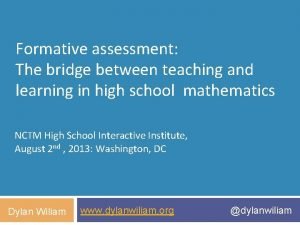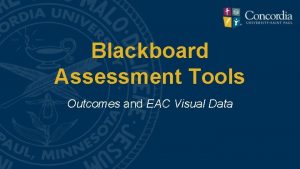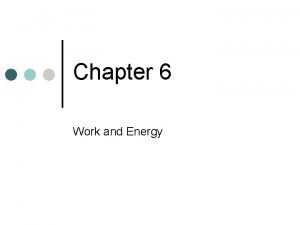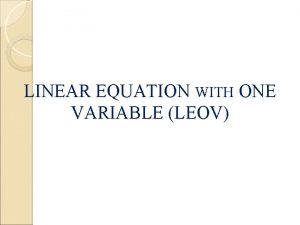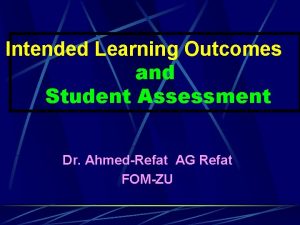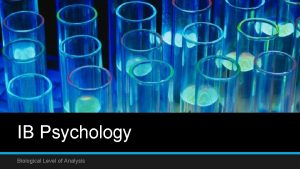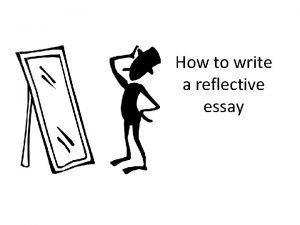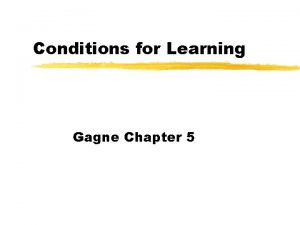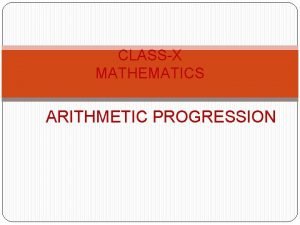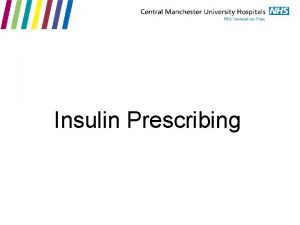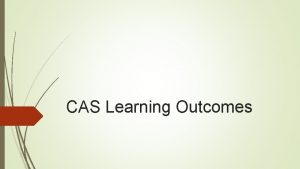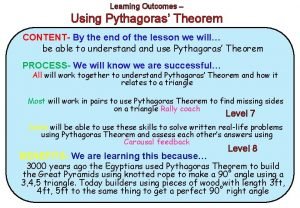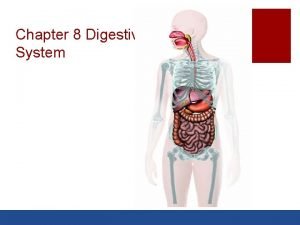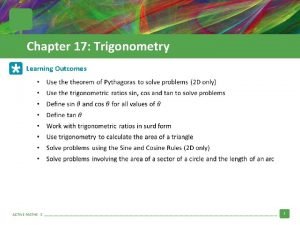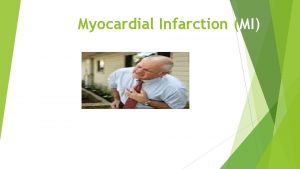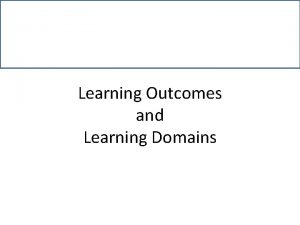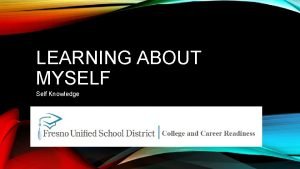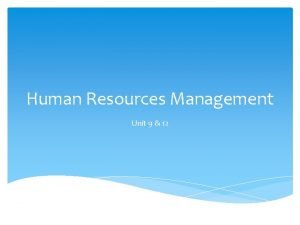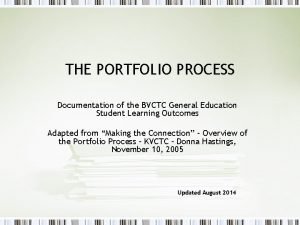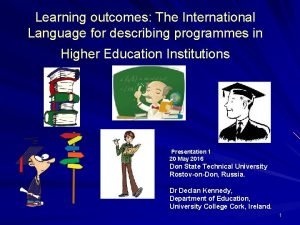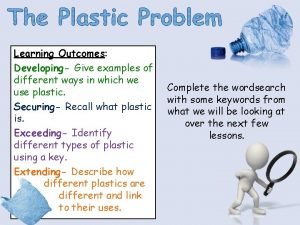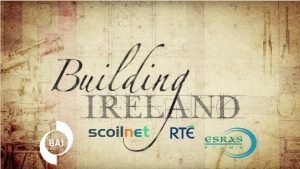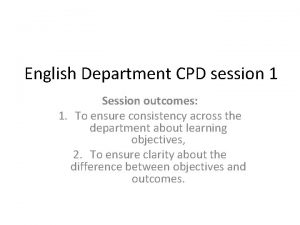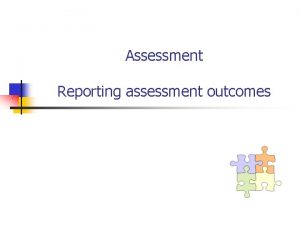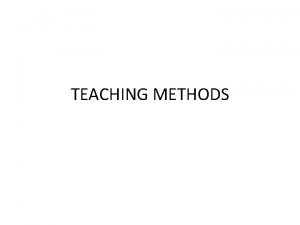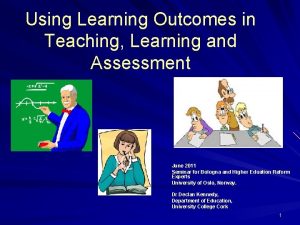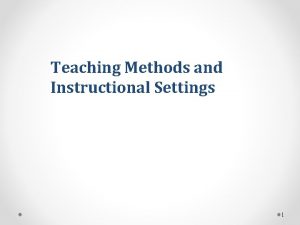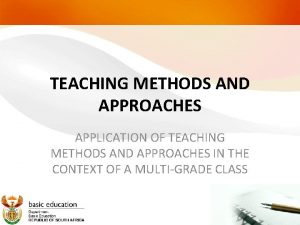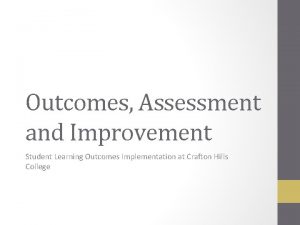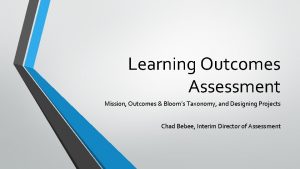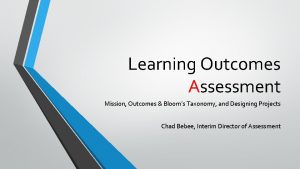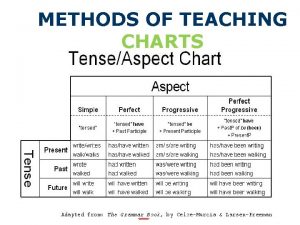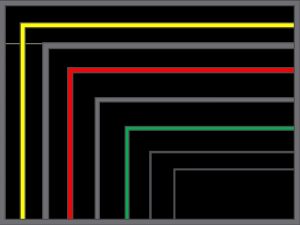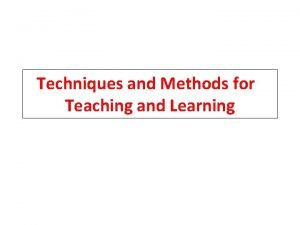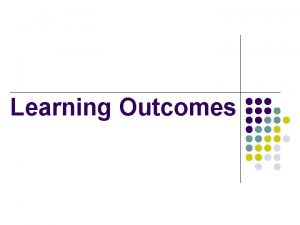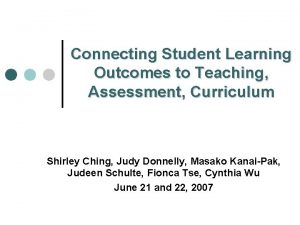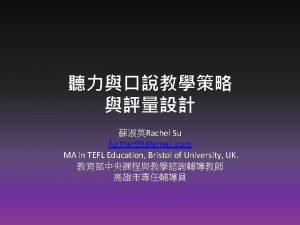LEARNING OUTCOMES Teaching learning and assessment methods Maria




























































- Slides: 60

LEARNING OUTCOMES Teaching, learning and assessment methods Maria Sticchi Damiani Tunis December 8, 2016

What are the foundations of learning outcomes in the EHEA? BASIC PRINCIPLES USEFUL TOOLS

BASIC PRINCIPLES 1. A student-centred approach (a) Programmes of study are designed on the basis of Ø defined learning outcomes “statements of what the individual knows, understands and is able to do on completion of a learning process” Ø estimated learning time (workload) “The time the individual typically needs to complete all learning activities, such as lectures, seminars, projects, practical work, work placements and individual study, required to achieve the defined learning outcomes in formal learning environments”. (ECTS Users’ Guide, 2015)

BASIC PRINCIPLES 1. A student-centred approach (a) For many HE systems this approach to curriculum design involves a shift in paradigm Øfrom teaching inputs to learning outcomes Øfrom teaching time to learning time Øfrom knowledge only to knowledge and skills that requires a change in academic culture

1. A student-centered approach (b) Programmes of study are delivered • giving learners enough choice of content, mode and pace of learning and helping them to build on their individual learning styles and experiences, • using effective teaching/learning methods, • providing learners with adequate educational guidance and facilities

2. Competences and Learning outcomes The two concepts are different, but closely related: Competence means ‘the proven ability to use knowledge, skills and personal, social and/or methodological abilities, in work or study situations and in professional and personal development’. Competences can be generic or subject-specific. Fostering competences is the object of a process of learning and of an educational programme. Learning outcomes express the level of competence attained by the student: ‘statements of what the learner knows, understands and is able to do on completion of a learning process’. They are formulated by academic staff and verified by assessment.

2. Competences and Learning outcomes Examples of Competences (from Tuning): Generic/transversal • Ability to apply knowledge in practical situations • Ability for analysis and synthesis • Ability to communicate in a second language • Elementary computer skills • Ability to identify, pose and resolve problems • Ability to work in a team • Ability to work autonomously Subject-specific • Ability to use and evaluate tools for analyzing a company in its environment (Business) • Skills in the safe handling of chemical materials (Chemistry) • Competence in a number of teaching/learning and assessment strategies (Education)

USEFUL TOOLS 1. General cycle descriptors (The Dublin Descriptors) • they describe the general learning outcomes expected for achieving a qualification in each of the three cycles and • become more specific as they are applied to specific degree courses/disciplines in each cycle

The Dublin Descriptors are based on five main elements: • Knowledge and understanding • Applying knowledge and understanding • Making judgements • Communication skills • Learning skills

Example I: First cycle descriptors Qualifications that signify completion of the first cycle are awarded to students who • have demonstrated knowledge and understanding in a field of study…. at a level supported by advanced textbooks…with some aspects informed by knowledge at the forefront of the field of study; • can apply their knowledge and understanding …. and have competences for devising and sustaining arguments and solving problems within their field of study; • have the ability to gather and interpret relevant data (usually within their field of study) to inform judgements…. ; • can communicate information, ideas, problems and solutions to both specialist and non-specialist audiences; • have developed those learning skills that are necessary for them to continue to undertake further study with a high degree of autonomy.

Example II: A single descriptor in the three cycles Making judgements - progression of the competences First cycle: have the ability to gather and interpret relevant data (usually within their field of study) to inform judgements… Second cycle: have the ability to integrate knowledge and handle complexity, and formulate judgements with incomplete or limited information… Third cycle: are capable of critical analysis, evaluation and synthesis of new and complex ideas

2. The ECTS credit system ECTS credits express the volume of learning based on: • definition of the expected learning outcomes (rather than teaching inputs) • estimation of their associated student workload (rather than teaching hours)

The ECTS credit structure is based on • 60 ECTS credits, corresponding to the learning outcomes and associated workload of a full time academic year (whatever it means in single countries), but may also take into account • national provisions concerning the number of working hours per academic year: in the EHEA countries the workload of a full time academic year ranges in most cases from 1500 to 1800 hours. So, in the EHEA, one credit generally corresponds to 25/30 hours of work.

The objectives of the ECTS system are to facilitate: Ø the design and transparency of study programmes Ø the delivery and enhancement of study programmes Ø the recognition of the learning achievements of mobile students

Design and transparency of study programmes

Design and transparency of a study programme The following steps have been identified as helpful in designing programmes: Programme context Programme profile Programme learning outcomes Programme structure and credit allocation Single educational components The outcomes of these steps should be described in a standard format in the Course Catalogue

Design and transparency of a study programme Responsibility for each step Collective responsibility (academics in consultation with relevant stakeholders): 1. Setting the programme in the context of the relevant national legislation and existing qualifications frameworks 2. Defining the programme profile, with the field(s) of study, the level of the programme, the key learning outcomes expected, the learning environment and the main learning, teaching and assessment activities 3. Defining the programme structure, with the type, number and size (credits allocated) of educational components

Responsibility of single teachers 3. Defining the learning outcomes of single educational components, consistently with the number of credits allocated (workload) and the general learning outcomes of the programme. 4. Defining the learning activities of the component, consistently with the learning outcomes defined for it and the credits allocated (workload) 5. Defining assessment methods and criteria, consistently with the learning outcomes defined and the learning activities carried out.

Design and transparency of a study programme Programme context Decisions on the programme’s cycle/level and related number of credits are based on national legislation and the National Qualifications Framework, if available

Design and transparency of a study programme Programme context Example from the Course Catalogue: Ø Ø qualification awarded: Laurea in Storia length of programme: 3 years number of credits: 180 level of qualification: First cycle

Design and transparency of a study programme Programme profile It includes: • The distinctive features of the programme • The main focus of the programme • The learning environment • The field(s) of study • The key learning outcomes • The main learning teaching and assessment activities

Design and transparency of a study programme Programme profile Example from the Course Catalogue: The Degree programme in History has the objective of preparing students for the practice of historical research, thanks to a solid knowledge of the great historiographical themes and debates, the acquisition of methodologies of the treatment and interpretation of the sources, and the use of a clear and rigorous language as appropriate to historiographical discourse. The learning experience is organised through cycles of lectures, seminars, workshops and laboratories. Alongside these activities, the students are able to attend conferences and meetings in order to have contact with scientific debate at national and international level. The Degree programme has four tracks: Ancient History, Medieval History, Modern History and Contemporary History.

Design and transparency of a study programme Programme learning outcomes Based on the programme profile, the learning outcomes express the level of the general or subjec-specific competences to be attained by the student. They should be: Ø Ø Ø succinct and not too detailed; mutually consistent developed by the components of the programme easily verifiable achievable within the workload

Design and transparency of a study programme Programme learning outcomes Example from the Course Catalogue: Graduates of the First Cycle Degree programme in History will be able to demonstrate a critical understanding of the relationship between the present and the past; knowledge of and an ability to use the basic techniques of historical research; the ability to identify the relevant scientific literature, bibliography and sources to address a historiographical problem; the ability to communicate research results in various ways according to the target audience; a knowledge of and ability to use the main tools of other social and humanistic sciences, besides history; a solid knowledge of the general lines of human history; specialised knowledge of one broad period of history (Ancient, Medieval, Modern/Contemporary); an ability to communicate in at least one language of the EU, in addition to their native one; as well as basic ICT competences for communicating, retrieving and elaborating on historiographical texts and data.

Design and transparency of a study programme Programme structure and credit allocation • Identify the constituent parts of the programme (e. g. , course units, work placement, laboratory work, dissertation, etc. ) • Break down the overall structure of the programme into components (modules? ) and define the learning outcomes of each component • Allocate the credits available (60 credits for a full-timeequivalent academic year) to the single components according to the estimated workload required to achieve the learning outcomes defined for each of them

Design and transparency of a study programme Programme structure with credits Example from the course catalogue: SECOND CYCLE DEGREE IN GLOBAL CULTURES First Year WORLD HISTORY 12 OCEANIC STUDIES 12 HISTORICAL ANTHROPOLOGY AND EARLY MODERN GLOBALIZATION 6 GLOBALIZATION AND ITS MALCONTENTS 12 GEOGRAPHIES OF GLOBAL CHALLENGES 6 SENIOR SEMINAR IN GLOBAL HUMANITIES 6 DIGITAL HUMANITIES: SOURCES AND METHODS 6 Total 60

Second Year 3 courses (6 ECTS each) from the following list: ETHNICITY AND IDENTITY IN THE GREEK WORLD 6 ROME AND THE UNIVERSAL 6 CROSS-CULTURAL ENCOUNTERS IN THE MEDIEVAL WORLD 6 HISTORY OF CULTURAL EXCHANGES IN THE MODERN AGE 6 GLOBAL HISTORY OF THE LONG NINETEENTH CENTURY 6 HISTORY OF COLONIAL AND POST-COLONIAL SPACES 6 18 One course (6 ECTS) from the following list: INTELLECTUAL HISTORY OF COLONIAL AND POST-COLONIAL SOUTH ASIA 6 6 NARRATIVES ON OTHERS AND SELF IN ARAB CULTURE 6 COLONIALISM AND AFRICA 6 POLITICS OF CONTEMPORARY ASIA 6 One course (6 ECTS) from the following list: 6 CHRISTIANITY IN A GLOBAL CONTEXT 6 CRITICAL THEORIES OF CONTEMPORARY CAPITALISM 6 FEMINIST CRITIQUES OF POLITICAL AND SOCIAL THOUGHT 6 GEOGRAPHY AND COGNITION OF EUROPEAN TERRITORY 6 ELECTIVES 6 FINAL DISSERTATION 24 TOTAL 60

Design and transparency of a study programme Information on individual educational components: code title type (compulsory/optional) cycle (short/first/second/third) year of study when the component is delivered (if applicable) semester/trimester when the component is delivered number of ECTS credits allocated name of lecturer(s) learning outcomes mode of delivery (face-to-face/distance learning etc. ) prerequisites and co-requisites (if applicable) course content recommended or required reading and other learning resources/tools planned learning activities and teaching methods assessment methods and criteria language of instruction

Design and transparency of a study programme Individual educational components Define: Ø Learning outcomes, ØLearning activities and teaching methods ØAssessment methods and criteria

Design and transparency of a study programme Individual educational components Ensure that: Øthe defined learning outcomes of the single educational components are fully consistent with the programme learning outcomes Øin the educational component the learning activities and assessment methods/criteria are consistent with the defined learning outcomes

Design and transparency of a study programme Individual educational component Example from the course catalogue Physics I (10 credits) Learning outcomes The student who successfully completes the course will have the ability to master the basic concepts of Physics both in Newtonian mechanics and in classical elecromagnetism. He/she will be able to demonstrate a solid knowledge of the conservation laws and of the Maxwell equations whose application will allow him/her to solve basic problems of dynamics in mechanical systems and of fields configuration in elecromagnetism.

Design and transparency of a study programme Individual educational component Example from the course catalogue Phyisics I (10 crediti) Learning activities Course requirements will include attendance of lectures, laboratory work and individual study for a global student workload of 250 hours, that will be allocated as follows: • • 60 hours for lectures 40 hours for work in the laboratory 145 hours for individual study 5 hours for exams

Design and transparency of a study programme Individual educational component Example from the course catalogue Physics I (10 crediti) Assessment methods: • Final written exam • Final oral exam The written exam is considered a threshold to access the final oral exam. A score of 15 points/30 is required to pass the written exam. Once threshold is passed, the weight of the oral exam on the final score is about 70%. Assessment criteria: The student will be assessed on his/her demonstrated ability to understand the main contents of the course and to adapt them to specific cases to solve problems. In the written exams (3 hours, two problems), the student must demonstrate his/her capability to deploy the basic concepts to find correct answers to a typical series of three questions per problem. During the oral exam (half an hour) the student must demonstrate the ability to put into practice with critical awareness the most important physics law discussed in the course.

Delivery and enhancement of study programmes

Delivery and enhancement of study programmes When delivering the programme, ensure that Ø Ø there is a constructive alignment between: the learning outcomes defined for each educational component, the teaching/learning activities provided to achieve them, the assessment methods/criteria adopted to verify they have been achieved teaching/learning and assessment activities in all components are fully consistent with the learning outcomes to be achieved and the learning time allocated to achieve them. students’ different needs and learning styles are accommodated through flexible learning paths

Delivery and enhancement of study programmes After delivering the programme Ø monitor whether the defined learning outcomes have in fact been achieved with the estimated workload, which means that credit allocation is realistic How? Feedback from students, staff and stakeholders through questionnaires, focus groups, interviews and results achieved Ø if monitoring results show that credit allocation is unrealistic, revise the student workload or the learning outcomes

Recognition of the learning achievements of mobile students

Recognition of the learning achievements of mobile students Basic concepts: Credit recognition is the process through which a qualification-awarding institution certifies that certain learning outcomes achieved and assessed in another institution satisfy certain requirements of the programme they offer.

Decisions on credit recognition require reliable information on the number of credits gained and the learning outcomes achieved in the other institution, as well as on the means of assessment and their validation.

The approach to credit recognition should be flexible, as different programmes in different higher education institutions in different countries very seldom offer educational components with the same learning outcomes and the same number of credits

Recognition of the learning achievements of mobile students in bilateral agreements (Erasmus+) 1. the period of study abroad is planned by the home institution with the mobile student on the basis of reliable information and a Learning Agreement is signed before departure, aiming at: - the achievement of a set of learning outcomes, which are compatible with those of the home programme; - the acquisition of an adequate number of credits,

2. All credits included in the LA, Ø gained abroad and Ø certified by the host institution through an official Transcript, are Ø recognized by the home institution upon return of the student, Ø transferred into the student’s records Ø used to satisfy specific requirements of the home qualification.

Recommendations for sending institutions: 1. Develop a programme of study abroad for a semester or a year (about 30 or 60 ECTS credits), including units at the appropriate level, with similar, complementary or coherent learning outcomes in relation to the curriculum of the home institution. 2. Do not look for one-to-one recognition of single units, but recognize the whole set of credits gained abroad for the approved programme and transfer it into the home curriculum, as a substitute for an equivalent number of credits, in order to satisfy the qualification’s requirements.

The ECTS grading scale

The ECTS grading scale Background Grading/marking practices and cultures in Europe are different due to 1. different national grading scales 2. different use of the same grading scale in different contexts

1. Different national grading scales Broader/narrower range of passing marks: • from a minimum of 1 (e. g. , pass or fail) • To a maximum of 14 (e. g. , from 18 to 30 cum laude in the Italian system)

2. Different use of the same grading scale in different contexts “Marking higher or lower? ” • Different types of institutions • Different subject areas or types of degree programmes

Grading in international mobility Main objectives correct interpretation and fair conversion of the grades gained in institutions abroad What can be done?

A two-step procedure Transparency describe the national scale as actually used in a programme of study to allow for a correct interpretation of the grades received by single students Conversion develop a common device at international level to allow for a fair conversion of the grades received by single students from a programme of study to another

For transparency, produce a grade distribution table (with percentages and cumulative percentages) for every programme of study or group of homogeneous programmes, to indicate the level of performance of a student with reference to the group s/he belongs to, and to enable partners to interpret correctly the grades awarded in each specific context. For conversion, compare directly the two grade distribution tables from the host and home programme of study to identify the corresponding grades.



Employability

Main goals of higher education: Ø Self-realization ØActive citizenship ØEmployability

Employability empowers the individual to make a living by seizing the opportunities available on the labour market. As labour markets are rapidly changing, higher education should equip students with the advanced knowledge, skills and competences they need throughout their professional lives.

Some suggestions for higher education institutions Ø Define programmes’ learning outcomes also in consultation with stakeholders like employers and graduates, in order to identify the general and specific competences that might be relevant to the demands of national and/or international labour markets’ Ø Develop stable relationships with the world of work, in order to bring in teachers with practical experiences, whenever the programme requires them, or to create job placement opportunities for the students Ø Follow up graduates’ careers, in order to to monitor the impact of single degrees on the labour market

Ø Adopt teaching/learning aproaches that may encourage students to become independent learners Ø Provide lifelong learning opportunities that might enable students to: obtain qualifications through flexible learning paths, part-time studies and work-based routes, extend their knowledge and understanding in specific areas, gain new skills and competences, as required by the labour market. Ø

Priorities of the EHEA Ministers for 2018 The Yerevan Communiqué 2015 2. Fostering the employability of graduates throughout their working lives “We need to ensure that, at the end of each study cycle, graduates possess competences suitable for entry into the labour market which also enable them to develop the new competences they may need for their employability later on throughout their working lives. ”

A transparency tool for employability: the Diploma Supplement The Diploma Supplement model was developed by the European Commission, Council of Europe and by UNESCO before the start of the Bologna Process. It was designed to provide a description of the nature, level, context, content and status of the studies that were pursued and successfully completed by the individual named on the original qualification to which it is appended. It is free from any value-judgements, equivalence statements or suggestions about recognition. It was adopted by the EHEA with the purpose to provide sufficient independent data to improve the international transparency and fair academic and professional recognition of qualifications (diplomas, degrees, certificates etc. ).

THANK YOU FOR YOUR ATTENTION!
 Features of portfolio assessment
Features of portfolio assessment Portfolio assessment matches assessment to teaching
Portfolio assessment matches assessment to teaching Assessment: the bridge between teaching and learning
Assessment: the bridge between teaching and learning Blackboard outcomes assessment
Blackboard outcomes assessment Example of learning objectives
Example of learning objectives Objectives of reported speech
Objectives of reported speech Monitor is input or output device
Monitor is input or output device Sound energy definition
Sound energy definition Learning outcomes of profit and loss
Learning outcomes of profit and loss Learning objectives of work and energy
Learning objectives of work and energy Indian and international number system
Indian and international number system Characteristics of direct instruction
Characteristics of direct instruction Microteaching meaning
Microteaching meaning Examples of learning outcomes
Examples of learning outcomes Learning outcomes of water cycle
Learning outcomes of water cycle Notice writing objectives
Notice writing objectives Objective of swot analysis
Objective of swot analysis Nursery rhymes importance
Nursery rhymes importance Photosynthesis takes place in
Photosynthesis takes place in Photosynthesis learning objectives
Photosynthesis learning objectives Domain 6: community linkages explanation
Domain 6: community linkages explanation Objectives of linear equations in one variable
Objectives of linear equations in one variable A machine that converts mechanical energy into electricity
A machine that converts mechanical energy into electricity Purpose of learning outcomes
Purpose of learning outcomes Ib psychology learning outcomes
Ib psychology learning outcomes How to write a reflective essay
How to write a reflective essay Learning outcomes of holy week
Learning outcomes of holy week Holy week learning outcomes
Holy week learning outcomes Head start early learning outcomes framework
Head start early learning outcomes framework Learning objectives of fruits
Learning objectives of fruits Gagne's five categories of learning
Gagne's five categories of learning Learning outcomes of arithmetic progression class 10
Learning outcomes of arithmetic progression class 10 Gift of chappals lesson plan
Gift of chappals lesson plan Cooking learning outcomes
Cooking learning outcomes Importance of domain 4 curriculum and planning
Importance of domain 4 curriculum and planning Humalog dosage scale
Humalog dosage scale Cas learning outcomes
Cas learning outcomes Conclusion of learning outcomes
Conclusion of learning outcomes State and prove pythagoras theorem
State and prove pythagoras theorem Learning about macronutrients
Learning about macronutrients Pharynge
Pharynge Learning outcome
Learning outcome Angina pathophysiology
Angina pathophysiology Hot seating questions examples
Hot seating questions examples Mqf 8 domains
Mqf 8 domains Learning outcomes of myself
Learning outcomes of myself Human resources learning outcomes
Human resources learning outcomes Business communication learning outcomes
Business communication learning outcomes Objectives of email writing
Objectives of email writing Training learning outcomes
Training learning outcomes Learning outcomes examples
Learning outcomes examples What are the objectives of mental health
What are the objectives of mental health Affective learning outcomes
Affective learning outcomes Learning outcomes definition
Learning outcomes definition Junior cycle history learning outcomes
Junior cycle history learning outcomes Verbs in psychomotor domain
Verbs in psychomotor domain Proseracer
Proseracer Learning outcomes framework
Learning outcomes framework Institutional learning outcomes examples
Institutional learning outcomes examples Cas learning outcomes
Cas learning outcomes Wax pattern in dentistry
Wax pattern in dentistry


